
Create an Account
Create an account for powerful AI tools, award-winning courses, and access to our vibrant community.
Already have an account?
New to homeopathy or re-familiarizing yourself?
I grew up with homeopathy and have used it throughout the years to treat ailments chronic and acute. But with the regime of herbals and nutritional supplements that I’ve been taking, homeopathy stayed on the sidelines for a while.
For those who haven’t read much about it, a homeopathic approach can be confusing. And, even among those of us who use it regularly, there is a tendency not to pause to think (or entirely inform ourselves) about the method and philosophy behind it.
I thought I’d use this post as an opportunity to cover some of the basics.
What is Homeopathy?

Homeopathy is a healing system alternative to traditional western medicine founded by Samuel Hahnemann, M.D. during the nineteenth century. The word “homeopathy” originates in two Greek words: homoios, meaning “similar,” and pathos meaning “sickness” or “suffering.” Homeopathy adheres to three basic principles, or “laws” — the Law of Similars, the Law of Proving, and the Law of Potentization (Panos, Heimlich 11–12). Many people use homeopathy in addition to or instead of allopathic medicine to treat physical, mental, and emotional disorders and ailments.
The Law of Similars
The Law of Similars is the statement that “like cures like.” After the symptoms have been examined, the patient is given the remedy that has been shown to produce those same symptoms in a person who is in good health. ‘Like cures like’ adheres to the thinking that the body’s natural vital response to an illness (the symptoms produced) is correct, and homeopathy works in conjunction with that response rather than as a suppressant (The School of Homeopathy). The Law of Similars is sometimes applied in therapeutics other than homeopathy. Traditional western medicine uses radium, known to cause cancer, to cure cancer. Likewise, amphetamine, a stimulant, can be effective in treating children for hyperactivity (Boyd 2). While western medicine is in agreement with the Law of Similars in the above two examples, the two are usually at odds. Traditional western practices most often use procedures targeted toward killing the problem or greatly subduing the symptoms through the use of medicines such as antibiotics or antihistamine. Homeopathy works to enhance the body’s own ability to fight the ailment (Ullman 10). Dr. Edward Bach, the creator of Bach Flower Remedies, compared the principles of homeopathy to the principles of vaccinations.
The Law of Proving
The Law of Proving involves the methods used to test the effects of specific remedies. To accomplish this, a group of healthy people is given a certain remedy for a set amount of time and his or her symptoms are carefully noted. Data from all testing is compared, and the consistent symptoms induced by specific remedies are recorded (Panos, Heimlich 11–12). This provides the reference for the application of the Law of Similars. The source for such findings is the homeopathic Materia Medica.

The Law of Potentization
The Law of Potentization deals with the process in which homeopathic remedies are created as well as the dosage to which they are given. The remedy is diluted to such an extent that it contains no molecules of the “original substance” from which it is derived — substances that range from minerals and metals to plants and even diseased tissue. There are various degrees of dilution for a given remedy known as potencies. As the remedy is increasingly diluted its potency also increases. Because of the diluted state, homeopathy is nontoxic, even though many of the substances from which they have been derived are very toxic (Panos, Heimlich 12).
How to Begin Using Homeopathy
Often, patients begin homeopathic treatment with a practitioner, unless they have attended workshops or seminars on the subject. If using homeopathy along with allopathic medicine, such as prescription pharmaceutical drugs, it may be an advantage to attempt to find a medical doctor who is also alternatively minded and knowledgeable of homeopathic approaches. If such a doctor is not practicing near where you are located, you will need to visit a homeopath in addition to a medical doctor. Many homeopaths offer telephone consultations.
Print Source References:
Boyd, Hamish. Introduction to Homeopathic Medicine. Bucks: Beaconsfield Press, 1989.
Panos, Maesimund B. and Heimlich, Jane. Homeopathic Medicine at Home. Los Angeles: J.P. Tarcher, Inc., 1980.
Ullman, Robert, and Ullman, Judith Reichenberg. The Patient’s Guide to Homeopathic Medicine. Edmonds: Picnic Point Press, 1995.
Want to have Melanie Demmer's latest posts delivered to your inbox?
Share Post